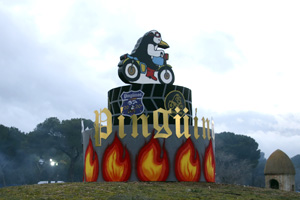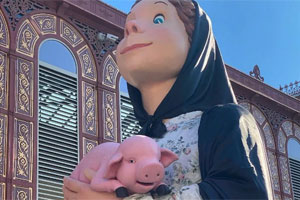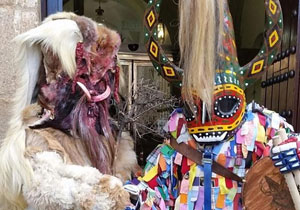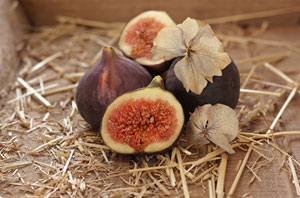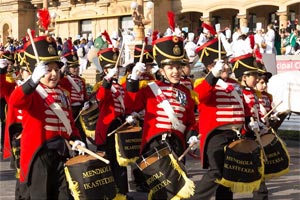Festivities of the Santísimo Cristo de la Vera Cruz in Cózar
How Cózar celebrates its patron saint fiestas
The patron saint festivities in honour of the Santísimo Cristo de la Vera Cruz are held from the eve of 14th September, the day of the patron saint, and last for five days in the town of Cózar.
Among the activities that visitors can enjoy are the Burning of the Toro de Fuego (Fire Bull) and the foot-tracking wheelbarrows, as well as the Juego de las Tacillas (Game of the Bulls) and the events surrounding its setting up, such as the bidding for the bulls and their presentation to the public.
Visitors will also be able to enjoy fireworks, tournaments and the music that will not be missing in the open-air dances that will take place every day.
Religious events will always be present, as the figure of the Cristo de la Vera Cruz is very much loved and deeply rooted by all the inhabitants of the municipality of Cózar.
The Cristo de la Vera Cruz will go out in procession with popular fervour on the 14th of September. And there will also be masses on the same day.
Bull of Fire
This is a frame or structure representing the figure of a bull, which carries a person inside it. The structure is surrounded by fireworks and pyrotechnic elements.
The fireworks are lit and the bull begins to run through the crowd, which tries to avoid the fireworks that shoot out of the sides of the bull and can hit those who are close to it and run along with the Toro de Fuego.
The bull runs through the streets of the village launching its fireworks accompanied by the people who run alongside it.
This tradition is recreated in the patron saint festivities of other Spanish municipalities.
The game of Las Tacillas
A tradition that still survives today and has been recorded since the 14th century. And it is possibly even older. It has been passed down from generation to generation.
It is a game of chance, in which you can win (and lose) money by betting.
It is well known and loved in the region of Campo de Montiel, and is also played in the town of Villapalacios (which is 50km from Cózar) and is known as El Juego de la Taza.
What are Las Tacillas like?
The Tacillas are made of cement. An oval shape is delimited with bricks and filled with cement. The dimensions are 2.20 metres long and 1.30 metres wide, and approximately 25 centimetres deep.
Near one end there will be three holes, which is where the balls will end up after being released: a central one, called 'La Cazuelilla' or 'La Taza' of about 12cm in diameter, and two elongated ones at its side, 14 centimetres long and 2 centimetres wide called 'Las Rendijas'.
Its cross-sectional view is similar to that of an egg cut in half. The concave shape is so that when the balls are dropped they end up in the holes due to the action of gravity.
There are eight balls. They are made of baked clay, about 18 millimetres in diameter. They are in charge of rolling through La Tacilla.
The Tacillas belong to the Brotherhood of the Santo Cristo de la Veracruz. There are currently two sets of the Tacilla in Cózar, behind the hermitage of the Cristo de Vera Cruz.
The Puja for the Tacillas
In Cózar, on the eve of the day of the Cristo de la Vera Cruz, close to midnight, a bid is placed in the village church for the Tacillas.
In this way, the villager who offers the most money will be in charge of managing the game during the patron saint's fiestas (known as the tacillero), and will be responsible for ensuring that the game runs smoothly.
In the last few editions the price for being in charge of Las Tacillas has exceeded 10,000 euros.
This expense is then supposed to be compensated when, during the course of the game, the players who win, traditionally donate generous tips to the Las Tacillas manager.
How is Las Tacillas played?
When it is a player's turn, he or she occupies a stool, which is at one end of the oval. At the other end, remember, are the Cup and Slot holes.
The player decides the amount of money to be played and deposits it in the oval. There is no minimum or maximum limit on the bet.
The rest of the players who participate in the game and surround La Tacilla, will all contribute the same amount bet by the player who is going to win, agreeing on the amount each one contributes and with the supervision of the tacillero. This is called 'casar'.
It must be remembered that it is forbidden to get angry, everyone must follow the rules and respect them.
Once the quantities have been 'matched', the tacilero (the person in charge of the tacila) hands the balls to the player, who holds them to the floor and leaves them free. The balls after rolling will end up distributed between the cracks and the casserole, and their number will determine who wins.
If the number of balls left in the bowl is EVEN. Shout 'PAIRS'. The player sitting inside wins. The tacilero collects all the money and hands it over. A PAR result also includes that there are no balls in the pot (all would be in the cracks) or that all (all eight) have ended up in the pot, to which 'ROYALS' is shouted.
If the number of balls left in the Bowl is an EVEN number. The shooter will shout 'NONES' and the outside players may collect their share plus the proportional share of the bet of the player who dropped the balls.
The player may fold (stand up) at any time, but if he/she decides to stay after winning, he/she must not take the money from the previous bet, and this amount must be the amount of the next game.
It is compulsory for the player to tip the dealer when he stands up, usually in proportion to the winnings. If he loses, he is not obliged to do so, but he may also do so, giving a good example of knowing how to lose to all those present.

